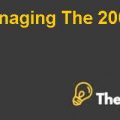This case reviews the proposed acquisition of Dow Chemical Company, Rohm and Haas in 2008. $ 18.8 billion acquisition was part of the strategic transformation of Dow slow growth, low profitability, and cyclic producer of basic chemicals to higher growth, higher-margin and more stable producer of performance chemicals. At the same time, Dow signed an agreement to form a joint venture with Petrochemical Industries Company (PIC) of Kuwait, a deal that will generate $ 7 billion in cash that could be used to fund all cash offer to buy Rohm and Haas. Dow and Rohm Rohm announced the merger July 10, 2008, just before the financial crisis in September 2008. The focus of the event that occurred after the financial crisis turned into a global economic crisis. Dow, like all chemical products, suffered as the global economy fell into recession in the second half of 2008, and as financial markets froze. What's worse, the PIC has canceled a joint venture with Dow in December 2008. As a result, Dow was wounded on three fronts: first, it has lost an important source of funding for the proposed acquisition, and secondly, the financial condition of the company Dow and internal cash flow deteriorated (its share price fell by more than 70% in 2008), and third, Rem forecast sales, profits, and the cost has gone down thus reducing its attractiveness as a target acquisition. Given this set of circumstances, Dow filed a lawsuit to cancel the merger agreement with Rohm in January 2009. Rohm answered with his lawsuit to force the closing of the transaction. As of February 2009, the board of directors of Dow and CEO Andrew Liveris to decide what to do first to acquire Rohm and pending litigation, but also to reduce the financial firm, the performance of the joint venture and the PIC.
by Benjamin C. Esty, David Lane Source: Harvard Business School 22 pages. Publication Date: November 16, 2010. Prod. #: 211020-PDF-ENG
“Dow’s” bid for “Rohm and Haas”
1. Introduction:
The case presents an American company Dow, producer of commodity chemicals who is in the final stages of acquiring another company Rohm and Haas (Rohm). Dow’s CEO had been working for four years to transform Dow from producer of low-value, highly cyclical commodity chemicals to a producer of high-value specialty chemicals and advanced materials. Rohm is a perfect match for Dow in respect of the strategic and financial perspective. Dow was also pursuing another key deal with Kuwait’s Petrochemical Industries Company (PIC) that supposed to generate $7 billion cash net of tax which could be used to finance acquisition of specialty chemical maker Rohm and Haas (Rohm) for $18.8 billion. By late 2008, financial crunch over financial institutions, US and global markets, as well macroeconomic factors grew worse. This in turn effected the global platform as well. PIC terminated the joint venture with Dow in December 2008 and to make matters worse, was Dow’s fourth quarter loss of $1.6 billion. Based on such recessionary period, Dow also went for terminating its proposed acquisition of Rohm, but in response, Rohm approached court to force Dow for the planned acquisition as per the agreement, as there is an explicit provision included in the merger and acquisition agreement which removes any such possibility.
2. Problem Statement:
Following points are addressed in this report;
- Determine why does Dow want to acquire Rohm and Haas.
- Evaluate using the Original Forecast, sensitivity analysis, growth and cost synergies effect, sensitivity analysis of cost synergies and was $78 per share bid reasonable?
- Evaluate using the Revised Forecast, sensitivity analysis, growth and cost synergies effect, sensitivity analysis of growth and cost synergies. What price per share is reasonable?
- Analyze various provisions in Exhibit 4 and identify major deal risks, to whom and how does the agreement allocate key risks, what risk does each provision address, which party ultimately bears the risk.
- Determine what should Andrew Liveris (Dow’s CEO) and Raj Gupta (Rohm and Haas’ CEO) do.
3. Analysis / Result:
Let us consider and analyze the above mentioned points. Also refer to the Excel Sheet;
Determine why does Dow want to acquire Rohm and Haas:
Rohm and Haas would be a strong operational and strategic fit for Dow. This acquisition would bring synergies as well as benefits in products and technologies, broad geographic reach, and strong industry channels. As discussed earlier, Rohm’ presence in the global market is a plus point for Dow as Rohm will provide Dow with an expanded network into emerging markets, which will be another important source of revenues and the synergies would create an outstanding business portfolio with diversified products and significant growth opportunities. Rohm is also backed up with a strong and experienced leadership team with a culture of customer focus and innovation. Dow’s CEO had been working for four years to transform Dow from producer of low-value, highly cyclical commodity chemicals to a producer of high-value specialty chemicals and advanced materials. Thus Rohm’s acquisition is a perfect match for Dow.
Evaluate using the Original Forecast, sensitivity analysis, growth and cost synergies effect, sensitivity analysis of cost synergies and was $78 per share bid reasonable:
For detailed calculations, please refer the excel sheet.
For the purpose of discounting cash flows to determine the present value of cash flows, we have caluclated WACC. Though Weighted average cost of capital (WACC) is provided in exhibit 7b, but it took tax rate to be 35% instead of 26% (as provided in Exhibit 7a) and debt ratio to be 28% instead of 49% (as provided in Exhibit 2). Following table shows the working of WACC calculation which was found to be 7.44%.
| Weighted Average Cost of Capital (WACC) | ||
| Calculation As per data | ||
| Risk-free Rate (Rf) |
4.92% |
|
| Equity Beta (bE) |
1.06 |
|
| Equity Risk Premium (ERP) |
5.07% |
|
| Cost of Equity (KE) |
10.29% |
|
| Tax Rate |
26% |
Exhibit 7a |
| Cost of Debt (KD) |
6.10% |
|
| Debt / Value Ratio (D/V) |
49% |
Exhibit 2 |
| Equity / Value Ratio (E/V) |
51% |
|
| WACC = |
7.44% |
|
Using the original forcast for cash flows, calculations have been done to value Rohm and Haas on a stand-alone basis. Following table shows calculations.
| Assumptions: | Perpetuity rate | ||||
| Tax Rate = |
26.00% |
Exhibit 7a | |||
| Base Growth Rate = |
2.00% |
5.44% |
Exhibit 7b | ||
| Growth Rate sensitivity 1 = |
1.00% |
6.44% |
Assumed for sensitivity | ||
| Growth Rate sensitivity 2 = |
3.00% |
4.44% |
Assumed for sensitivity | ||
| Base WACC |
7.44% |
5.44% |
Calculated from given data. Its also near the lowest range of WACC in Exhibit 7b | ||
| WACC sensitivity 1 |
8.52% |
6.52% |
Exhibit 7b | ||
| WACC sensitivity 2 |
9.50% |
7.50% |
Exhibit 7b highest range of WACC | ||
| ORIGINAL Forecast at the Deal Announcement (7/10/08) |
1 |
2 |
3 |
4 |
|
|
2009 |
2010 |
2011 |
2012 |
||
| Revenue |
$10,286 |
$10,897 |
$11,517 |
$12,132 |
|
| Earnings bef. Interest, Taxes, and Depr. (EBITDA) |
$1,633 |
$1,793 |
$1,996 |
$2,223 |
|
| Depreciaton & Amortization |
$503 |
$507 |
$512 |
$521 |
|
| Earnings before Interest and Taxes (EBIT) |
$1,130 |
$1,286 |
$1,484 |
$1,702 |
|
| Earnings before Interest After Taxes (EBIAT) |
$836 |
$952 |
$1,098 |
$1,259 |
|
| + Depreciation & Amortization |
$503 |
$507 |
$512 |
$521 |
|
| - Capital Expenditures |
($555) |
($556) |
($553) |
($558) |
|
| - Increases in New Working Capital (NWC) |
($280) |
($295) |
($310) |
($325) |
|
| Total Free Cash Flow |
$504 |
$608 |
$747 |
$897 |
|
|
BASE CASE with WACC 7.44%, g 2% |
Present value |
$469 |
$526 |
$602 |
$674 |
| Enterprise value |
$14,908 |
per share | 76.37 | ||
| Equity value |
$11,836 |
per share | 60.64 | ||
Enterprise value is calculated to be $14.9 billion, using WACC (7.44%) as calculated above and growth rate 2% as provided in Exhibit 7a. This is calculated without including synergy. Effect of synergy is shown below. Per share equity value is also shown above which excludes the amount of debt and includes cash.Dow’s Bid for Rohm and Haas Case Solution
Perform a sensitivity analysis based on the inputs to the TV (discount rate and growth rate):
Using the sensitivity analysis by variations in WACC and growth rate valuation is done as shown below. WACC as calculated in Exhibit 7b (8.52%) and the highest range of WACC (9.5%) provided in exhibit 7b are used for sensitivity. The lowest range provided therein (7.5%) is already near the WACC (7.44%) calculated above. Growth rate as provided in exhibit 7a is 2% therefore for sensitivity analysis 3% and 1% is used on assumption basis. Using these sensitivity figures, calculations have been done as below:
This is just a sample partial case solution. Please place the order on the website to order your own originally done case solution












